Cottage cheese is a tasty, creamy and versatile ingredient that deserves a permanent place in your refrigerator. But what exactly is cottage cheese and where does it come from? Here’s everything you need to know about this kitchen staple.
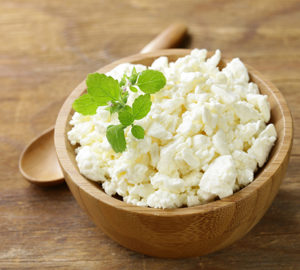
¿What is Cottage Cheese?
Cottage cheese is essentially curds (formed when an acid curdles the milk) and cream. Like ricotta, mozzarella, feta and goat cheese, cottage cheese is a fresh cheese, meaning it is not cured like parmesan and cheddar.
Although people have been eating something similar for thousands of years, the name Cottage dates back only to the mid-19th century, It is believed to be the first cheese made in the United States. It was brought to the United States from Europe.
The story is that cottage cheese used to be made on farms or cottages, where they had excess milk from butter making and used the extra milk to make cottage cheese. Hence the name.
¿How is it made?
Cottage cheese is fermented. Like all dairy products, it starts with milk. The addition of enzymes or live, active cultures (probiotics) converts the milk sugars (lactose) into lactic acid. The lactic acid separates the curd (the milk solids, fats and proteins) from the whey (the liquid).
At this stage, the curd is basically a solid block of cheese. A knife-type curd cutter is responsible for cutting the cheese into bite-sized pieces. Whether the cottage cheese is small or large curd depends on the design of the curd cutter.
Cutting the curd releases a lot of whey. We then drain off the whey and are left with a nice curd. The curd is then mixed with cream.
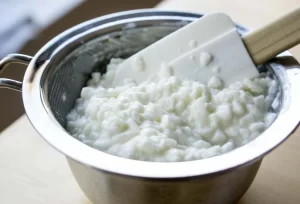
Substitutes
¿No Cottage? No problem. Ricotta is probably the best substitute for cottage cheese, as they have similar flavors and textures. Here are other alternatives to cottage cheese that may work well depending on the recipe:
- Mascarpone
- Feta cheese
- Sour cream
- Cream Fresh cheese
- Yogurt
- Kefir
- Mozzarella
- Goat cheese
- Feta
Benefits
Cottage cheese has also been associated with several health benefits.
It may help prevent insulin resistance. Insulin resistance can lead to the development of type 2 diabetes and heart disease. However, calcium in dairy products is believed to reduce insulin resistance. In fact, one study suggests that dairy consumption can reduce the risk of insulin resistance by 21%.
May promote bone strength. In addition to calcium, cottage cheese is a good source of phosphorus and protein. These nutrients have been consistently linked to improved bone health.
High in selenium. A 1-cup (226-gram) serving of cottage cheese provides 37% of the RDI for selenium. This mineral has been shown to increase antioxidant protection in the blood (1, 22Trusted Source, 23Trusted Source).
¿How does it taste?
Cottage cheese varies not only in the size of the curd, but also in its consistency and taste. Cottage cheese should not have a pasty or viscous texture, it should resemble yogurt in thickness and creaminess. Less separation between curd and cream creates a smoother mouthfeel.
Cottage cheese should have a mild, clean, milky flavor, with just a hint of salt. It may have a subtle acidity depending on how it was grown and its fat content. Nonfat and low-fat cottage cheese (2 percent) have a more acidic taste, while full-fat (4 percent) and high-fat (6 percent) have a creamier taste.
Serving ideas for cottage cheese
Homemade cottage cheese is, of course, delicious on its own or topped with fruit. It can also be salted by adding chopped tomatoes and red onions and seasoning it with ground black pepper. You can turn it into a sauce by combining it with ranch sauce, or use it in place of ricotta when making lasagna. Either way, homemade cottage cheese is delicious.
How to Make Cottage Cheese at Home
Believe it or not, you can make homemade cottage cheese in the comfort of your own kitchen with just three ingredients: milk, vinegar and salt. You’ll also need a small saucepan, a strainer and a cheesecloth.
Ingredients:
- 4.5 lts whole milk
- ¾ cup white vinegar
- 1 teaspoon salt
- 3 tablespoons of milk cream
Step by step:
- Pour the milk into a large heavy-bottomed saucepan. Heat slowly to 190°F/88°C, stirring regularly so that the milk does not burn on the bottom of the pot.
- Remove from the heat, pour in the vinegar and stir several times. Cover and let stand for 30 minutes.
Meanwhile, line a colander with a clean piece of double gauze or a kitchen towel. Place the strainer over another bowl to catch any liquid (whey) that drips out. - Spoon the solids from the pot into the lined strainer. Allow to drain for 30 minutes.
- Gather the ends of the cloth tightly together and form a cheese ball wrapped in the cloth. Holding it with one hand, run cold water over the ball, kneading and squeezing it with the other hand until the whole cheese ball is cold.
- Remove the cheese from the cloth and place it in a bowl and use a spoon to break it into small curds. Add salt to taste.
For a creamy ricotta, add 2 tablespoons of cream at a time until it reaches the desired consistency. Check the taste and add more salt if necessary. - Chill for at least 1 hour and stir before serving.
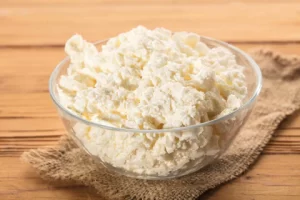
Differences between Ricotta vs. Cottage cheese
Cottage cheese and ricotta look alike, and sometimes one can substitute for the other, but they are very different things. While ricotta is made from coagulated cow’s milk, cottage cheese is made from the by-products of other cheeses (such as mozzarella). They also differ in texture and flavor: ricotta is thick and slightly salty, but cottage cheese is creamy and slightly sweet.
Cottage cheese can be used instead of ricotta in certain cooked recipes (such as lasagna), as it has a similar texture and fewer calories.
How to consume cottage cheese
Cottage cheese can be consumed in the same way as yogurt: alone, with fruit or vegetables, blended in smoothies or even cooked in recipes.
How to store cottage cheese
Store the cottage cheese in the refrigerator in an airtight container (the one that came with it is probably fine). Keep it upside down to slow the growth of bacteria. If stored properly, it should last about 10 days after opening.
¿Can cottage cheese be frozen?
Cottage cheese can be frozen (like Quark), although its texture is slightly altered. It is better to eat it fresh or to freeze only the ricotta you are going to cook with. When baking lasagna with cottage cheese, for example, you should not notice the difference between fresh and frozen cottage cheese.
Nutritional table
The nutritional profile of cottage cheese varies depending on the level of butterfat used and the amount of sodium added.
One cup (226 grams) of low-fat cottage cheese (1% milk fat) provides the following:
Calories 163
Protein: 28 grams
Carbohydrate: 6.2 grams
Fat: 2.3 grams
Phosphorus: 24% of the Daily Reference Intake (RDI)
Sodium: 30% of the RDI
Selenium: 37% of the RDI
Vitamin B12: 59% of the RDI
Riboflavin: 29% of the RDI
Calcium: 11% of the RDI
Folate: 7% of the RDI
It also has decent amounts of vitamin B6, choline, zinc and copper.
The carbohydrate content of cottage cheese is around 3%. It is composed of lactose, a milk sugar to which some people are intolerant.
When consuming large amounts of cottage cheese, consider purchasing low-sodium or sodium-free varieties. High sodium intake raises blood pressure in some people, which can increase the risk of heart disease.
It should be noted that protein accounts for more than 70% of the calories in cottage cheese.
In summary, cottage cheese is an excellent source of protein and contains relatively few calories. It is also packed with many nutrients, such as B vitamins, calcium, phosphorus and selenium.


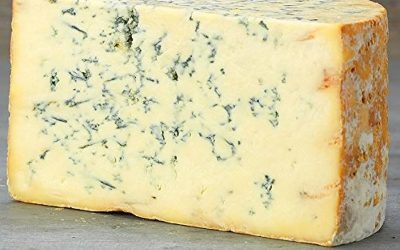
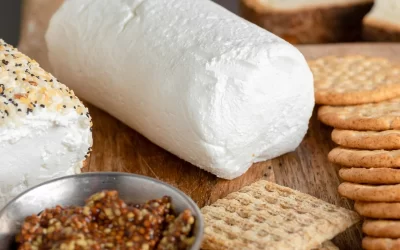

0 Comments